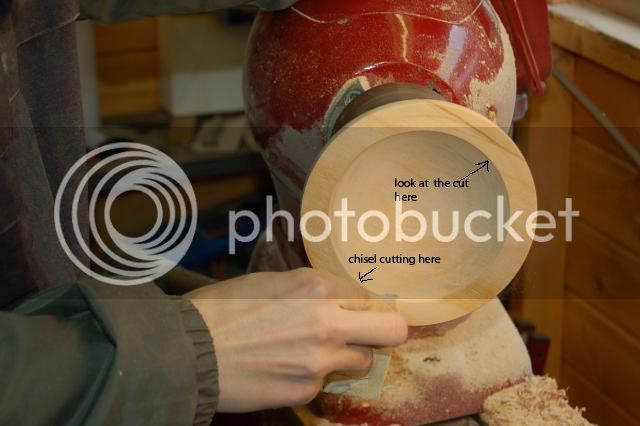wizer
Established Member
- Joined
- 3 Mar 2005
- Messages
- 15,589
- Reaction score
- 1
Went 'round to Blister's this morning to play. He kindly re-shaped and sharpened a couple of my tools and then chopped up some logs for me.

We screwed one of the split logs to my face plate. But decided it would be best not to use it until I have taken the corners off on the bandsaw.

So we rooted around in Allen's meagre ( :roll: ) timber supply and found a small piece of spalted sycamore.

After it was mounted on the screw chuck, I cut the chuck recess for the bottom and started to shape the outside. We marked the rim of the bowl with a parting tool.

I struggled a bit with shaping the outside of the bowl. It didn't turn out how we'd planned it. I'm not sure what the problem was. It just wasn't clicking with me.

This is the shape we ended up with after some sanding and sealer.

Shaping the inside went much better. I appear to be learning how to pick up the cut and follow it through evenly. Allen was nagging me to not look at the tool but the opposite side of the cut and I found that this helped substantially (when I did it).

Eventually we got to a nice even finish, using the teardrop scraper to get a nice finish. Then I sanded it through the grades.

Then on to waxing it with some briwax and buffing it up


Bit of an odd shape, but the missus was impressed. So I guess it's a winner
I'm making slow progress but I think I'm getting there.

We screwed one of the split logs to my face plate. But decided it would be best not to use it until I have taken the corners off on the bandsaw.

So we rooted around in Allen's meagre ( :roll: ) timber supply and found a small piece of spalted sycamore.

After it was mounted on the screw chuck, I cut the chuck recess for the bottom and started to shape the outside. We marked the rim of the bowl with a parting tool.

I struggled a bit with shaping the outside of the bowl. It didn't turn out how we'd planned it. I'm not sure what the problem was. It just wasn't clicking with me.

This is the shape we ended up with after some sanding and sealer.

Shaping the inside went much better. I appear to be learning how to pick up the cut and follow it through evenly. Allen was nagging me to not look at the tool but the opposite side of the cut and I found that this helped substantially (when I did it).

Eventually we got to a nice even finish, using the teardrop scraper to get a nice finish. Then I sanded it through the grades.

Then on to waxing it with some briwax and buffing it up


Bit of an odd shape, but the missus was impressed. So I guess it's a winner
I'm making slow progress but I think I'm getting there.






